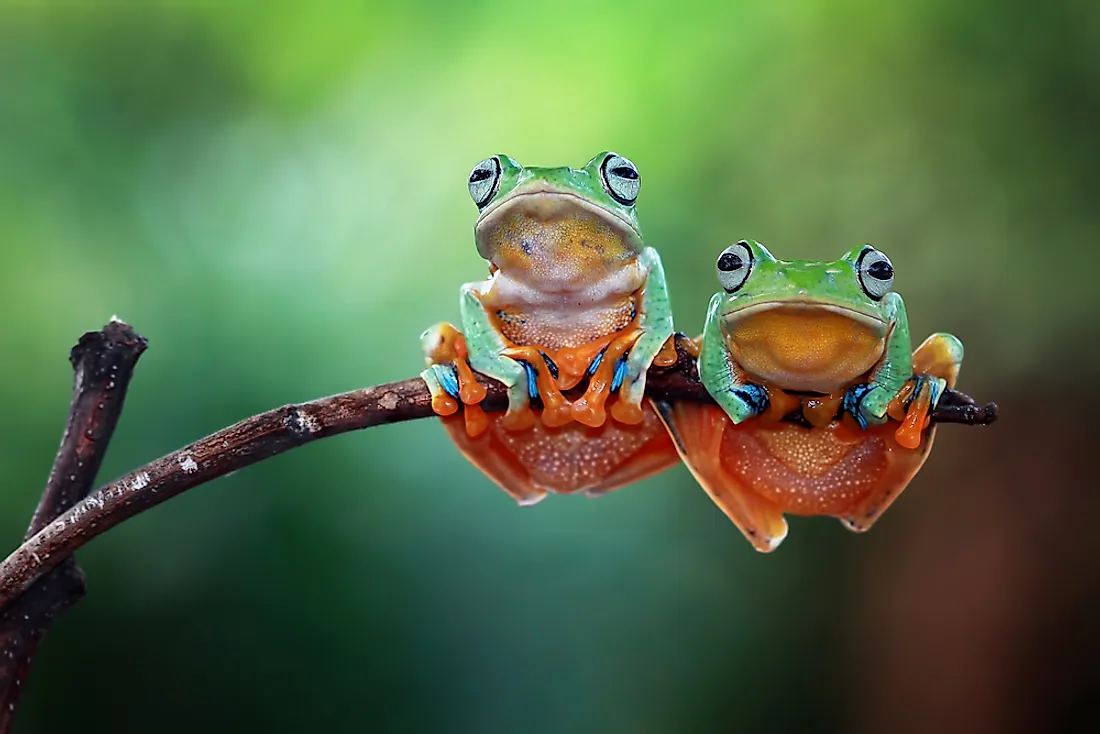Characteristics of Amphibians

Amphibians are animals that are characterized by their ability to survive both in water and on land. The name “amphibian” is derived from the Greek word “amphibious” which means “to live a double life.” There are over 6,500 living species of amphibians with the majority of the species living within fresh aquatic water ecosystem. Most of them are born in water and start off as a larva and develop a land-based lifestyle as they develop. The class Amphibia is divided into three modern orders:
- Anura, which includes the toads and frogs.
- Apoda, which comprises the caecilians.
- Urodela, which are mainly salamanders.
90% of all amphibian species are frogs. Below are some of the characteristics shared by the amphibians.
5. Egg Are Fertilized Outside of the Body
Most amphibians reproduce in fresh water while a few lay their eggs on land and have developed mechanisms to keep the eggs moist. Reproduction in amphibians has more similarities with the fish than with reptiles or mammals. Although they reproduce sexually, fertilization and development of the young ones take place outside the body.
4. Cold-Blooded
Although amphibians exhibit both terrestrial and aquatic characteristic, they are strictly cold-blooded or ectothermic. They do not have the internal mechanisms to regulate their own body temperatures like mammals do. They rely on the external environment to regulate their body temperature. Amphibians tend to bask in the sun to raise their body temperature and retreat to a cold place to lower their temperature. Their cold-blooded nature has limited the ecosystem in which they can thrive in since they cannot survive in areas of high or low temperatures. Amphibians do not have hair or fur to insulate them from heat loss. To survive the cold winter, most amphibians remain active throughout the period. Some also sink deep into the water to stay warm. Other species hibernate at the bottom of the ponds. Salamanders have the ability to antifreeze ice forming around them by converting glycogen into glucose.
3. Breathe Through Skin
Amphibians have primitive lungs compared to other amniotes. They possess large alveoli and few internal septa, responsible for a slow oxygen diffusion rate into the blood. The lungs have low internal volumes and cannot process as much air as mammals or reptiles. Some species of salamanders are lungless and have to employ other means to breathe. Most amphibians exchange gases or breathe through their moist, permeable skin. To facilitate sufficient gaseous exchange, the vascular skin of the amphibians must be moist. The moist skin allows the oxygen to diffuse at a sufficiently high rate. The process by which gaseous exchange takes place through the skin is called cutaneous respiration. Aquatic amphibians like the Titicaca water frog can rely entirely on cutaneous respiration since the concentration of oxygen in water increases at both low temperature and high rate of flow. A network of cutaneous capillaries enables for the exchange of gases and the diffusion of water and iron between the environment and the animal.
2. Carnivores
Amphibians are mainly carnivores and feed on almost anything that moves and they can swallow. The adult amphibian is a predator with its diet consisting of a wide variety of food. Some of these foods include spiders, earthworms, beetles, and caterpillars. Burrowing caecilians mainly feed on earthworms whereas salamanders and anurans feed mainly on insects and arthropods. Large amphibians can also feed on small vertebrates such as birds and mammals. Food is often selected by sight, even in areas with dim light.
1. Time Spent In Water and On Land
Amphibians spend their life both on land and in water. The term “amphibian” is a Greek word for “amphibious” which means “living a double life.” Most have a biphasic life cycle which involves the fertilization and development of eggs and larvae in water. The larvae metamorphose into a semi-terrestrial or terrestrial juvenile and adults. On the evolutionary tree, amphibians are found midway between fish which fully live in water and reptiles and mammals which lead a fully terrestrial lifestyle. Adult amphibians have to live near water since they need steady moisture supply in order to survive. They can be found in a wide range of habitat near water including swamps, streams, forests, and dump areas.











